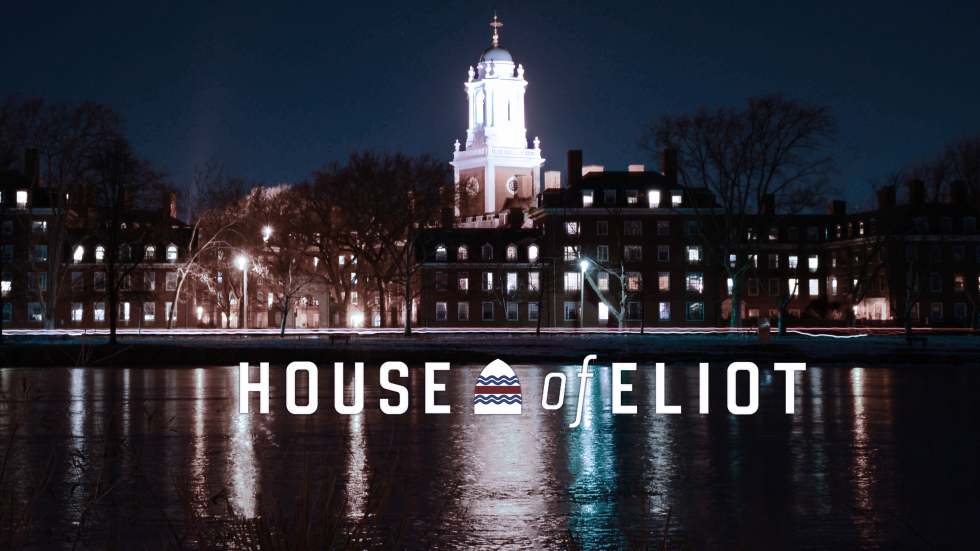
Eliot House is one of the 12 upperclassmen houses at Harvard, named after Charles Eliot, who served as president of the university for forty years and was responsible for some pretty great changes — like the introduction of the elective system and the construction of the Harvard Stadium, the Phillips Brooks House, and Johnston Gate. Often heard in the house is our beloved motto “Floreat Domus de Eliot”, which roughly translates to “Long Flourish Eliot House!”. Big days in a Domus year include the Housing Day and the legendary spring formal Fête.
Construction
Named in honor of Charles William Eliot, President of Harvard from 1869 to 1909, Eliot House was opened in 1931 as one of the seven original houses at the College. It was commissioned by Charles Eliot's successor, Abbot Lawrence Lowell, as a part of his House Plan designed to 'revitalize education and revive egalitarianism at Harvard College."
The House was built at a cost of $3 million from the benefaction of Edward Harkness (who also endowed the other six houses and the first colleges at Yale). Eliot House is situated along the banks of the Charles River, at the intersection of Memorial Drive and John F. Kennedy Street (formerly Boylston Street), on a site that was previously occupied by an electric power plant (which must explain why Eliot House has never won the Green Cup for energy conservation!).
Architecture
Architecturally, Eliot House is an example of the typical residential college, modeled after the colleges of Oxford and Cambridge. It was designed by the prominent Boston architectural firm Shepley, Bulfinch, Richardson and Abbot and is organized around three open courts: the Forecourt, the Great Court, and the Master's Court. The forecourt is not partcularly impressive due to the inside-out design of the House but serves as its entrance. The Great Court has a hexagonal shape because of the irregular nature of the site and is surrounded by seven buildings. On the west side, the building runs up to five stories, on the south and east, it only rises to three. The line of buildings is broken by an entirely open space in the middle and was done to "give the court the full benefit of the winter's sun, and the occupants of most of the rooms, a splendid view of the river."
Traditions
The many traditions of Eliot House have, over the years, served to give it a distinct character. The Eliot House shield is derived from the Eliot family arms and is described as silver (the field) between gemels wavy azure (paired wavy blue arms) derived from the Devonshire and Cornwall branches of the Eliot family, not the Charles River!
Similarly, the Eliot elephant comes from the crest of the Eliot family coat-of-arms and apparently, its facial characteristics were inspired by the profile of the first master of the House, Roger "Frisky" Merriman, and drawn by President Eliot's grandson. There are actually four elephants visible in the architecture of the house.
The house toast is "Floreat domus de Eliot" and its response is "Domus." All members of the house belong either to the Junior Common Room, JCR, or the Senior Common Room, SCR. The JCR includes all resident sophomores, juniors, and seniors in the house while the SCR includes the Master, Tutors, and all faculty affiliated with the house. Eliot House is also associated with its sister colleges Jonathan Edwards College at Yale and Emmanuel College at Cambridge University.
The Faculty Deans (né House Masters
In its more than 90 years of existence, Eliot House has had only seven co-masters, now called Faculty Deans. The first master was Roger Bigelow Merriam '96 (1931-42) who was chosen to establish the Oxbridge model of residential colleges at Eliot. He was succeeded by John Huston Finley '25 Ph. D. '33 (1942-68) who cultivated Eliot's somewhat deserved reputation as the bastion of Rhodes scholars, champion rowers, and Yankee aristocrats. Alan Heimert '49 Ph. D. '60 and his wife Arline Grimes Heimert were co-masters from 1968-1991, and they managed the introduction of co-education and co-residence at Eliot. The Heimerts were succeeded by Steve Mitchell and Kirstine Forsgard (1991-2000) who transitioned Eliot through the randomization process and the introduction of the housing "lottery." From 2000 to 2010, co-masters Lino Pertile and Anna Bensted guided Eliot through a period of growing house spirit and success in IM athletics, particularly rowing. From 2010-2010, Eliot Doug Melton and Gail O'Keefe served at the helm. In 2020, Eliot welcomed Kevin Madigan and Stephanie Paulsell to the domus.
Students
The house was originally built to accomodate two-hundred and ninety-four students in forty-seven single suites, ninety double suites, twenty-one triple suites, and one quadruple, ranging in price for each student from $100 to $580 a year. Freshmen (and they were, really, only men) were required to apply and interview for entrance to the House. However, "inflation" has increased both the number of students in the house and the cost per student to more than 430 and upwards of $76,000, respectively, today.
The House also included, as listed in a 1931 pamphlet, eight resident tutors, nine non-resident tutors, one resident associate, the Master, and one suite of rooms reserved for a Visiting Professor. Today, there are more than thirty resident tutors and non-resident tutors in various disciplines.
During World War II, U.S. Navy Office candidates from 1942-46 occupied Eliot House, and the linoleum in the dining hall is a legacy of that occupation as their repeated swabbings destroyed the original wooden floor! Eliot House also plays host to Harvard's prestigious Society of Fellows, which has a guest suite in "M" Entryway.
